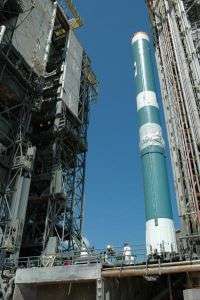GLAST Set to Launch Wednesday to Study Cosmic Mysteries

In a final meeting of scientists, engineers, technicians and officials, NASA's Gamma-ray Large Area Space Telescope (GLAST) received the final "Ready to Go!" from all teams. GLAST is scheduled to launch on a United Launch Alliance's Delta II Heavy rocket with a launch window from 11:45 a.m. - 1:40 p.m. EDT on Wednesday, June 11.
During the "Launch Readiness Review," a two hour meeting at NASA's Kennedy Space Center, Fla., held on June 9, the U.S. Air Force, NASA and United Launch Alliance reported on various aspects of the GLAST spacecraft, the Delta II Heavy rocket that will carry it, clearances, weather and the final remaining issues, which are now all closed.
The Launch Readiness Review (LRR) ended with an all-around approval for GLAST to launch on Wednesday, June 11, pending the weather. Joel Tumbiolo, U.S. Air Force Delta II Launch Weather Officer, 45th Weather Squadron, of Cape Canaveral Air Force Station noted that there is a 40% chance that weather issues will delay the launch. "The clouds are the concern," he told the LRR group. Typically, the sea breeze on Florida's east coast develops around noontime from June through September, and that can create clouds over land. There's a "Cumulus Cloud Rule" which states that if a cumulus cloud is a certain height, it must be a certain distance from the launch vehicle. There are no issues with winds, which are expected to be light.
Tumbiolo repeated his forecast during the GLAST pre-launch press conference held at 1 p.m. on June 9 at Kennedy Space Center, carried live on NASA-TV. He was part of a panel of six that included Dr. Jon Morse, Director, Astrophysics Division, NASA Headquarters; Omar Baez, NASA Launch Director/Launch Manager, Kennedy Space Center; Kris Walsh, Director of Delta NASA and Commercial Programs, United Launch Alliance; Kevin Grady, GLAST Project Manager, Goddard Space Flight Center; and Dr. Steven Ritz, GLAST Project Scientist/Astrophysicist, Goddard Space Flight Center. The Large Area Telescope (LAT) Principal Investigator, Peter Michelson, and others also attended the briefing and answered questions.
At the press briefing, Omar Baez explained that the tower rollback will occur just after midnight on Wed. June 11, on Launch pad 17-B, at Cape Canaveral Air Force Station.
Kris Walsh talked about the launch and what happens during and after ignition. She said that by about 10 minutes after launch, the Delta II carrying GLAST will be over the island of Antigua in the Caribbean. By around 75 minutes after launch, GLAST will be put into orbit approximately 300 nautical miles high over the Earth's surface. GLAST's orbit will be at an inclination of approximately 25.6 degrees to the equator.
Steve Ritz spoke about the exciting science that GLAST will reveal. He said that the GLAST LAT will survey the Universe over an energy range from 20 million electron volts to over 300 billion electron volts, the upper end of which is a relatively unexplored area of the electromagnetic spectrum. "GLAST enables scientists to look under the hood and see how the universe works," Ritz said.
Kevin Grady, GLAST Program Manager, explained how the Large Area Telescope, or LAT, doesn't have a lens like a regular telescope. In fact, it converts gamma rays to electrons and positrons to infer the direction from which the gamma-ray came.
"It took a lot of people in many countries to make this sixteen-year journey come to fruition," said Michelson. NASA partnered with the U.S. Department of Energy, and many institutions and agencies in the U.S, France, Germany, Italy, Japan and Sweden.
Right now, however, before all eyes turn to the gamma-ray sky that GLAST will show scientists around the world, all eyes at the launch site in Florida are on the weather.
Source: Goddard Space Flight Center





















